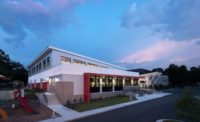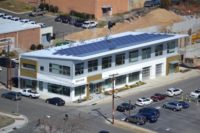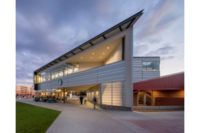Colorful Panels Envelop Humane Society
As the first LEED Gold certified animal shelter in the nation, the new Humane Society Silicon Valley (HSSV) Animal Community Center in Milpitas, CA proves that even our four-legged friends can enjoy the benefits of sustainability.

As the first LEED Gold certified animal shelter in the nation, the new Humane Society Silicon Valley (HSSV) Animal Community Center in Milpitas, CA proves that even our four-legged friends can enjoy the benefits of sustainability.


To meet ENERGY STAR certification qualifications, a material coating is measured for its solar reflectance (SR). This refers to the fraction of the incident solar energy that is reflected by a given surface using spectrophotometric measurements. An integrating sphere determines the reflectance at each different wavelength.Then, an averaging process reveals the average reflectance by using a standard solar spectrum. Higher numbers on the index indicate higher solar reflectivity, and thus more energy efficiency. The index ranges from 0 to 1 (or 0 percent to 100 percent), where 0 indicates the least reflective material, and 1 is most reflective. To achieve an ENERGY STAR certification, colors must reach a minimum of .25 on the scale. As one of the more distinguished standards, the California Energy Commission’s Building Energy Efficiency Standard, Title 24, requires that materials must have a solar reflectance of up to .20, depending on the climate zone.
 Cool building materials are also measured for their thermal emittance, which is defined by the Cool Roof Rating Council as the relative ability of a surface to radiate heat that is absorbed. Title 24 requires that materials must have a thermal emittance of up to .75, depending on the climate zone.
Cool building materials are also measured for their thermal emittance, which is defined by the Cool Roof Rating Council as the relative ability of a surface to radiate heat that is absorbed. Title 24 requires that materials must have a thermal emittance of up to .75, depending on the climate zone.
Another characteristic of panel performance is the Solar Reflectance Index (SRI), which is a measure of a material’s ability to reject solar heat. SRI is based on the Solar Reflectance and the Thermal Emittance. Standard black materials have a rating of 0 and standard white materials have a rating of 100. For a LEED credit, materials must reach an SRI of at least 29.
The panels on the HSSV Animal Community Center fulfill all of the criteria for the various standards, respectively achieving the following indexes:
 “We are proud to offer sustainable products to our customers,” says Byron Smith, West Region Vice President for Metal Sales. “We understand that facility owners and project teams are doing their best to engage in green building, and we want to assist in that effort. The Humane Society Silicon Valley highlights this commitment because Metal Sales was able to provide five different paint options that are all environmentally beneficial.”
“We are proud to offer sustainable products to our customers,” says Byron Smith, West Region Vice President for Metal Sales. “We understand that facility owners and project teams are doing their best to engage in green building, and we want to assist in that effort. The Humane Society Silicon Valley highlights this commitment because Metal Sales was able to provide five different paint options that are all environmentally beneficial.”
In addition to their sustainability benefits, the colorful metal paneled exterior provides a cheerful environment for employees, volunteers and community members to enjoy.
“The metal panels look beautiful and the facility owners are very pleased with the final results,” says Rich Palmer, Vice President of Kodiak Roofing and Project Manager of the HSSV Animal Community Center. “They installed exactly as planned, which is crucial when sticking to a tight construction schedule.”

Perhaps the HSSV will serve as a positive role model to other facility builders around the nation, as it proves that going green is good for every member of the animal kingdom.
The project team for the HSSV consisted of architect Swatt Miers, Emeryville, CA, installer Kodiak Roofing, Lincoln, CA, and general contractor Robert L. Brown Construction, Martinez, CA.

As the first LEED Gold certified animal shelter in the nation, the new Humane Society Silicon Valley (HSSV) Animal Community Center in Milpitas, CA proves that even our four-legged friends can enjoy the benefits of sustainability.
About the Center
The $25 million, 48,000-square-foot HSSV facility was completed in March 2009. It spans nearly five acres and was funded through public donations. Its “L” shaped site plan encourages a sense of community as it organizes the building’s many public entrances around a common entry space. For more than 80 years, HSSV has served Silicon Valley and has helped to find homes for more than 500,000 animals. The new building will facilitate improved care for animals, as it offers cage-less habitats and a wide variety of pet and community services. Its features include a spay/neuter center, a veterinary hospital, a dog park with a training center, boarding and grooming, doggie daycare, a community education center, an event space, a pet store and a pet-friendly café. The new space is large enough to accommodate up to 10,000 animal adoptions a year, but manages a minimal environmental impact.
Energy Efficient Features
Built with LEED in mind, the new shelter offers a host of eco-friendly features. The building has an extensive onsite solar energy generation system, which generates 40 percent of its energy needs from renewable resources. Its HVAC system features heat recovery wheels that capture and reuse heating and cooling during air ventilation cycles, which not only promotes energy savings, but also limits the spread of illness. It has a highly-efficient kennel cleansing system to minimize water usage, and stained concrete flooring to reduce the need for chemical cleaning. The center has onsite bioswales to remove pollution from rainwater runoff, and artificial turf in the dog park areas to lower irrigation water demand. Finally, the entire facility is enveloped in nearly 1,000 square feet of brightly colored and highly reflective metal panels, provided by Metal Sales Manufacturing Corporation.
Cool Building Envelope
Metal Sales’ 7/8” Corrugated, 24 gauge panels surround the new facility, offering a long-lasting sustainable exterior with a vibrant aesthetic. Five colors were chosen to bring visual interest to the structure, including PVDF Kynar 500 Copper Penny, Tahoe Blue, Terra Cotta, Hemlock Green and Jade Green. Like all colors, these are ENERGY STAR listed, signifying that they have been proven to substantially contribute to energy savings due to their high solar reflectivity.To meet ENERGY STAR certification qualifications, a material coating is measured for its solar reflectance (SR). This refers to the fraction of the incident solar energy that is reflected by a given surface using spectrophotometric measurements. An integrating sphere determines the reflectance at each different wavelength.Then, an averaging process reveals the average reflectance by using a standard solar spectrum. Higher numbers on the index indicate higher solar reflectivity, and thus more energy efficiency. The index ranges from 0 to 1 (or 0 percent to 100 percent), where 0 indicates the least reflective material, and 1 is most reflective. To achieve an ENERGY STAR certification, colors must reach a minimum of .25 on the scale. As one of the more distinguished standards, the California Energy Commission’s Building Energy Efficiency Standard, Title 24, requires that materials must have a solar reflectance of up to .20, depending on the climate zone.

Another characteristic of panel performance is the Solar Reflectance Index (SRI), which is a measure of a material’s ability to reject solar heat. SRI is based on the Solar Reflectance and the Thermal Emittance. Standard black materials have a rating of 0 and standard white materials have a rating of 100. For a LEED credit, materials must reach an SRI of at least 29.
The panels on the HSSV Animal Community Center fulfill all of the criteria for the various standards, respectively achieving the following indexes:
- Copper Penny: SR .45, Thermal Emittance .85
- Tahoe Blue: SR .30, Thermal Emittance .86
- Terra Cotta: SR .39, Thermal Emittance .85
- Hemlock Green: SR .36, Thermal Emittance .85
- Jade Green: SR .31, Thermal Emittance .86

In addition to their sustainability benefits, the colorful metal paneled exterior provides a cheerful environment for employees, volunteers and community members to enjoy.
“The metal panels look beautiful and the facility owners are very pleased with the final results,” says Rich Palmer, Vice President of Kodiak Roofing and Project Manager of the HSSV Animal Community Center. “They installed exactly as planned, which is crucial when sticking to a tight construction schedule.”

Sustainable Facility - Better Care
With its LEED Gold certification, the HSSV Animal Community Center not only has a positive impact on the environment, but the measures taken also facilitate better care for the animals. Improved airflow will minimize kennel cough and respiratory infection. The facility’s space-efficient design, coupled with the use of high-quality materials, will reduce noise and thus improve animal sleeping quality and stress levels. The advanced kennel cleansing will ensure proper disinfecting with minimal interruption to animals’ habitats and minimal use of water.Perhaps the HSSV will serve as a positive role model to other facility builders around the nation, as it proves that going green is good for every member of the animal kingdom.
The project team for the HSSV consisted of architect Swatt Miers, Emeryville, CA, installer Kodiak Roofing, Lincoln, CA, and general contractor Robert L. Brown Construction, Martinez, CA.
Looking for a reprint of this article?
From high-res PDFs to custom plaques, order your copy today!





